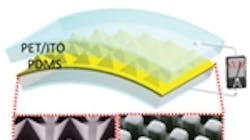Harvesting energy from plastics
Scientists have discovered another way to harvest tiny amounts of electricity from motion in everyday activities, and it involves capturing the electrical charge produced when two different plastic materials rub against each other. Based on flexible polymer materials, this so-called “triboelectric generator” could provide ac power from activities such as walking.
The new generator could supplement power produced by nanogenerators that use the piezoelectric effect to create current from the flexing of zinc oxide nanowires. What’s more, because the triboelectric generators can be made nearly transparent, they could offer a new way to produce active sensors that might replace technology now used in touch-sensitive displays.
“The fact that an electric charge can be produced through this principle is well known,” says Zhong Lin Wang, a professor in the School of Materials Science and Engineering at Georgia Tech. “What we’ve introduced is a gap separation technique that produces a voltage drop, which leads to a current flow, allowing the charge to be used. This generator can convert random mechanical energy from our environment into electric energy.”
The triboelectric generator operates when a sheet of polyester rubs against a sheet made of polydimethysiloxane (PDMS). The polyester tends to donate electrons, while the PDMS accepts them. Immediately after the surfaces rub together, they are mechanically separated, creating an air gap that isolates the charge on the PDMS surface and forms a dipole moment. If an electrical load is then connected between the two surfaces, a small current will flow to equalize the charge potential. By continuously rubbing the surfaces together and then quickly separating them, the generator can provide a small alternating current.
The technique could also be used to create a sensitive self-powered active pressure sensor for potential use with organic electronic or opto-electronic systems. The force from a feather or water droplet touching the surface of the triboelectric generator produces a small current that can be detected to indicate the contact. Because the devices can be made approximately 75% transparent, they could potentially be used in touch screens to replace existing sensors. The next step is to create systems that include storage mechanisms for the generated current. For more information, visit gatech.edu.
